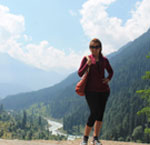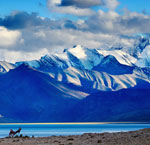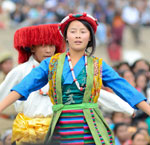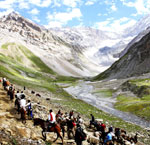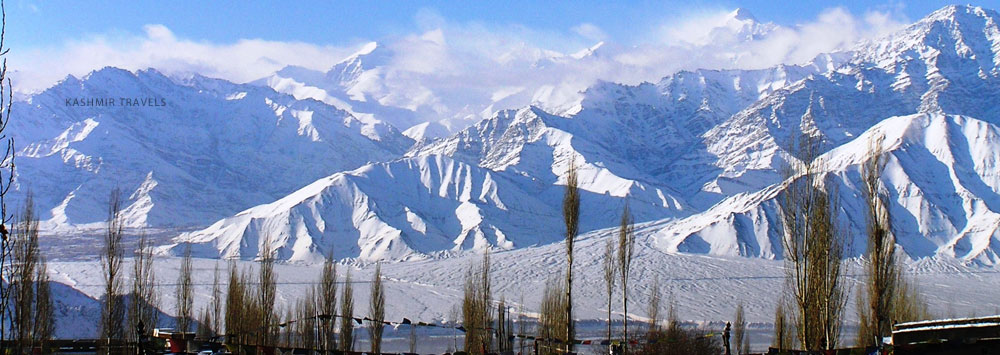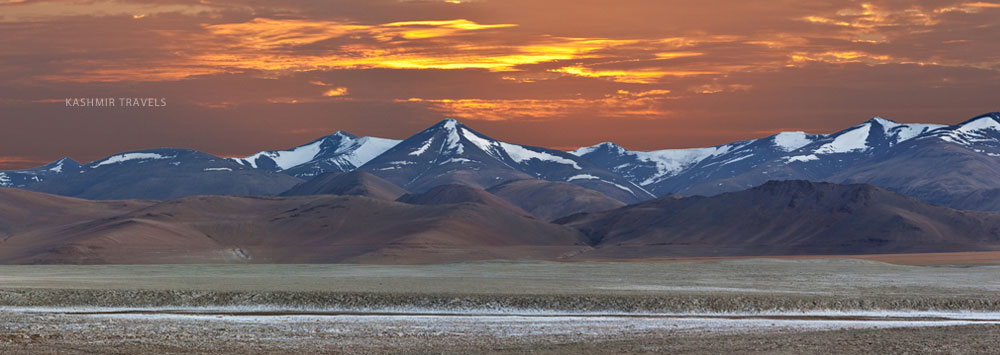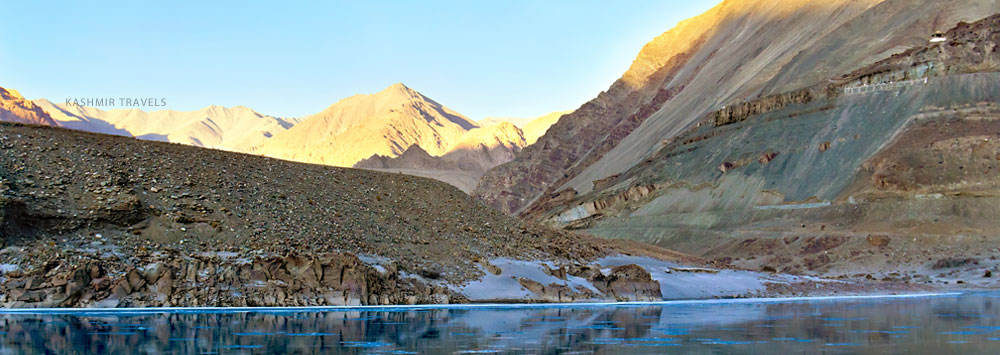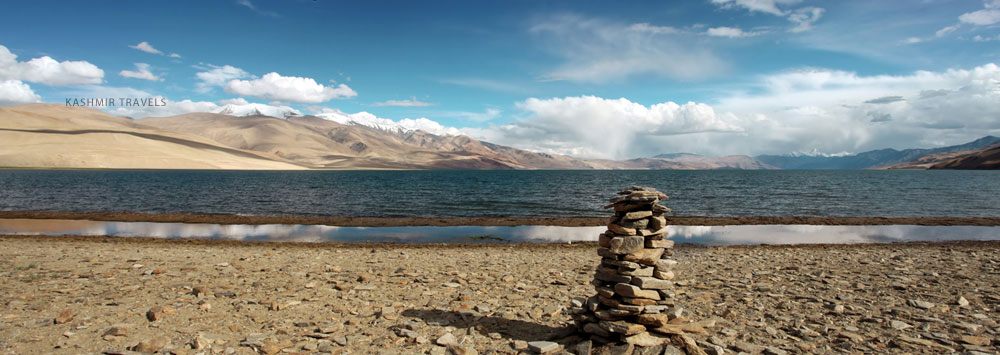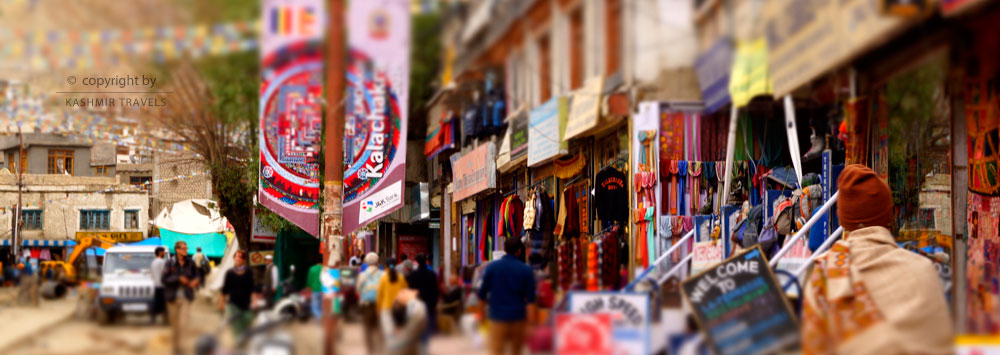Ladakh
Lamayuru
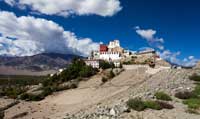 Lamayuru western Ladakh is another interesting and a beautiful place. It is the home of the most spectacularly situated monastery. Lamayuru 15 km from Fotu-la, the most mysterious and oldest monastery in Ladakh, on whose walls scenes of beatific calm mingle with vigorous, gory depictions of ogres and demons. The paradoxical duality pits peace and gentleness with violent turbulence. This is the first patch of welcome green. It is after leaving Kargil that one notices the gaping difference in the two worlds - the green velvety mountains have become harsh and dry and change into the most inconceivable colors. At every curve, there is a new shape, a new color, an entire valley in the form of a honeycomb made out of sand - a mountain that looks like a fort, a monastery, perhaps. Strange, silent villages sulk in the valleys.
Lamayuru western Ladakh is another interesting and a beautiful place. It is the home of the most spectacularly situated monastery. Lamayuru 15 km from Fotu-la, the most mysterious and oldest monastery in Ladakh, on whose walls scenes of beatific calm mingle with vigorous, gory depictions of ogres and demons. The paradoxical duality pits peace and gentleness with violent turbulence. This is the first patch of welcome green. It is after leaving Kargil that one notices the gaping difference in the two worlds - the green velvety mountains have become harsh and dry and change into the most inconceivable colors. At every curve, there is a new shape, a new color, an entire valley in the form of a honeycomb made out of sand - a mountain that looks like a fort, a monastery, perhaps. Strange, silent villages sulk in the valleys.Lamayuru, where the Dalai Lama stayed on his way to Leh in the September of 1976, presents a cool welcome oasis of green. With its carefully tended vegetation and clean white-washed appearance, Lamayuru is a charming spot. A narrow bridle path leads to it from the road - the “gompa” towers above, silent and mysterious.
Entering the courtyard, sunny and bare, there is the sound of unseen chanting which increases as one ascends to the small terrace of a room, where a monk chants in a high-pitched voice with his head lowered in front of a picture. As visitors approach, he offers to show them around, picking up a large bunch of keys and proceeding to unlock doors - empty with improvised altars, a few pictures; some richly furnished with carpets, Tibetan tables, pricelesstankhas, pictures and offerings while brass jugs provide the butter for the two butter lamps that stay constantly lit on each altar. In the head lama’s room 200 monks pray together before a colossal statue of Avolo-kiteshvara with eleven heads and 1,000 hands.
The air hangs heavy with the fragrance of incense, musk and butter from the lamps the sense and feeling is of timelessness, as the century’s fall away one by one leaving the spectator in limbo, midst the silent footfalls of divinity. Perched on top of steep cliff, the monastery is, to all appearances, inaccessible; belonging to the Griguna Sect, it is the oldest 10th Century monastery in Ladakh.
Lamayuru is one of the oldest sites in Ladakh. Legend has it that a vast lake once filled theupper reaches of this valley. The sage Naropa miraculously breached this. The site of the breachwas revered, and became the location of the Gompa, which was built in the 10th century. Oneof the original Gompas is just beyond the main assembly hall and has been recently renovated.
The Gompa subscribes to one of the older Tibetan schools, the Kargyupaorder, which wasfollowed by the noted sages Marpa(1012–97) and Milarepa(1040–1123). For many of the outlyingGompas in the region, the doctrinal distinctions are merely technical – for example, thoseat Wanlah, Phanjila and Khalsi, although affiliated with the region, also have close cultural linkswith the main Drukpagompa at Hemis.
In recent years Lamayuru as well as a number of other Gompas in Ladakh have changed theirannual masked dance festival to the summer. While this may help to boost the coffers from thetourist dollar it has not been popular with the local villagers, and in particular those in the vicinityof Khalsi. Many of villagers looked forward to attending the festival during the long wintermonths while in the summer they are busy with the fields and cannot spare the time to attend.
Lamayuru is also famous for the vast opportunities of trekking. It forms an important part of Leh-Ladakh trekking. Treks done in this part of Ladakh are fascinating and interesting and absolutely exciting.
CIN : U63040DL2008PTC177736 Government of India
Reg No : Reg/2019/DT/42/l-2 Government of J&K Tourism

